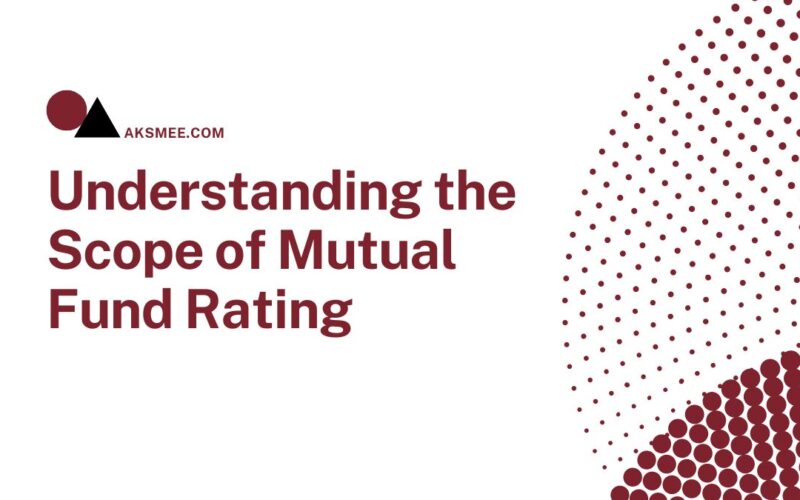One of the most important factors for investors to think about when making a mutual fund investment is the fund’s rating. A mutual fund rating offers an overview of the risk, return potential, and historical performance of the fund. In order to make well-informed investment selections, it is imperative that rookie and expert investors alike comprehend the extent of mutual fund ratings.
This blog post will examine the different facets of mutual fund ratings, including their definition, methodology, importance, and practical applications for investors. The limitations of mutual fund ratings will also be covered, along with some advice on factors to take into account in addition to the ratings themselves.
What is a Mutual Fund Rating?
A mutual fund rating is a performance and quality statistic given by rating organizations or financial services firms to its clients. These ratings usually have a five-point rating system, where one star denotes a poor performance compared to peers and five stars indicates a high performance.
Ratings for mutual funds are determined by a number of criteria, such as past performance, risk tolerance, expense ratios, and consistency. These rankings are dynamic and subject to shift as the fund’s performance does.
How Are Mutual Fund Ratings Determined?

Ratings for mutual funds are usually established by combining quantitative and qualitative data analysis. Although the methods used by various rating agencies may differ slightly, the fundamental ideas are typically the same. Below is a summary of some typical variables taken into account when rating mutual funds:
- Historical Performance: The fund’s past returns over various time frames, such as one year, three years, and five years, are analyzed. Funds that consistently perform well are likely to receive higher ratings.
- Risk-Adjusted Returns: Simply looking at raw returns can be misleading if the fund took excessive risks to achieve them. Rating agencies often adjust returns for the level of risk taken to provide a more balanced view. A popular metric for this is the Sharpe ratio.
- Expense Ratio: The cost of managing the fund, represented by the expense ratio, is also factored into the rating. Lower expense ratios can positively impact the rating since they leave more money in the hands of investors.
- Consistency: Funds that demonstrate consistent performance across different market conditions are favored. Consistency indicates reliable management and strategy.
- Volatility: The degree to which a fund’s returns fluctuate is also considered. Funds with lower volatility are often preferred by conservative investors, leading to better ratings in that context.
- Portfolio Management: The expertise and track record of the fund managers play a crucial role. Rating agencies often assess the management team’s experience and decision-making skills.
Example of Mutual Fund Rating Table
To better understand how mutual fund ratings work, let’s look at an example table that compares three different mutual funds:
| Fund Name | Rating | 1-Year Return (%) | 3-Year Return (%) | 5-Year Return (%) | Expense Ratio (%) | Volatility (Beta) |
|---|---|---|---|---|---|---|
| Alpha Growth Fund | 4 Stars | 12.5 | 9.8 | 11.2 | 0.75 | 1.10 |
| Beta Balanced Fund | 3 Stars | 8.7 | 7.2 | 8.1 | 1.00 | 0.95 |
| Gamma Income Fund | 5 Stars | 7.3 | 6.8 | 7.0 | 0.60 | 0.85 |
In the table above, you can see how different factors like returns, expense ratios, and volatility contribute to the overall rating of each fund. The Gamma Income Fund, for example, has a lower return than the Alpha Growth Fund, but its lower expense ratio and lower volatility give it a higher overall rating.
Significance of Mutual Fund Ratings

Mutual fund ratings serve as a quick reference for investors to gauge the quality and potential of a mutual fund. Here’s why they are significant:
- Simplifies Decision-Making: For investors who may not have the time or expertise to analyze all the factors that go into mutual fund performance, a rating provides a straightforward way to compare funds.
- Benchmarking: Ratings allow investors to benchmark a fund against its peers. A fund with a higher rating in its category indicates better relative performance.
- Risk Assessment: By considering risk-adjusted returns, ratings help investors understand the level of risk they are taking on. A high-rated fund with moderate risk can be more attractive than a high-risk, high-return fund.
- Manager Evaluation: Ratings can reflect the effectiveness of the fund management team. Consistent high ratings often signal a competent and reliable management approach.
Limitations of Mutual Fund Ratings
While mutual fund ratings are valuable, they are not without their limitations. Understanding these limitations can help investors avoid over-reliance on ratings alone.
- Past Performance is Not Indicative of Future Results: Ratings are largely based on historical performance, which may not always predict future success. Market conditions, economic factors, and changes in management can all impact future performance.
- Different Rating Agencies, Different Methodologies: Not all ratings are created equal. Different rating agencies may use different criteria and weighting for their ratings, leading to variations in the ratings of the same fund.
- Ratings Can Change: A fund’s rating can fluctuate based on short-term performance, changes in management, or shifts in market conditions. A fund that is highly rated today might not hold that rating in the future.
- Does Not Consider Individual Investor Needs: Ratings are generalized and may not consider individual investment goals, risk tolerance, or time horizons. A highly rated fund may not necessarily align with an individual’s specific investment strategy.
- Overemphasis on Stars: Investors may sometimes focus too much on the star ratings, neglecting to dive deeper into the factors behind the rating. It’s important to consider the underlying metrics and how they fit with personal investment goals.
How to Use Mutual Fund Ratings Effectively
Given the limitations, how should an investor use mutual fund ratings in their decision-making process? Here are some tips:
- Use Ratings as a Starting Point: View mutual fund ratings as a tool to narrow down your choices, not as the final determinant. Once you’ve identified highly rated funds, dig deeper into the specifics.
- Look Beyond the Stars: Consider the factors contributing to the rating, such as expense ratios, volatility, and management quality. Assess whether these factors align with your investment goals.
- Diversify: Even if a fund is highly rated, it’s important not to put all your eggs in one basket. Diversify your portfolio across different funds, asset classes, and risk levels to mitigate potential losses.
- Stay Updated: Keep an eye on rating changes and understand why they occurred. If a fund you’re invested in sees a significant downgrade, it might be time to reassess your position.
- Consider the Fund’s Category: Compare the fund with others in the same category. A five-star rating in a high-risk category may still be riskier than a three-star rating in a more conservative category.
Conclusion
Mutual fund ratings are a valuable tool in an investor’s arsenal, providing a snapshot of a fund’s historical performance, risk levels, and management quality. However, it’s important to understand the scope and limitations of these ratings. They should be used as a guide rather than the sole basis for investment decisions.
Investors should consider ratings as one piece of the puzzle, alongside other factors such as individual investment goals, risk tolerance, and market conditions. By using mutual fund ratings effectively, investors can make more informed decisions and build a well-rounded investment portfolio that aligns with their financial objectives.
